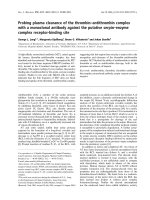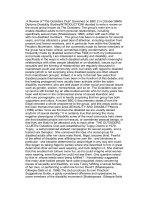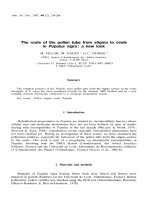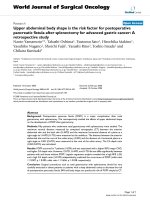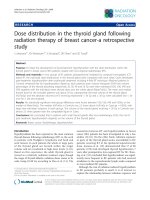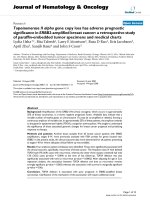Plasma levels of the MMP-9:TIMP-1 complex as prognostic biomarker in breast cancer: A retrospective study
Bạn đang xem bản rút gọn của tài liệu. Xem và tải ngay bản đầy đủ của tài liệu tại đây (1.35 MB, 12 trang )
Thorsen et al. BMC Cancer 2013, 13:598
/>
RESEARCH ARTICLE
Open Access
Plasma levels of the MMP-9:TIMP-1 complex as
prognostic biomarker in breast cancer:
a retrospective study
Stine B Thorsen1†, Sarah LT Christensen1†, Sidse Ø Würtz1, Martin Lundberg2, Birgitte S Nielsen1, Lena Vinther1,
Mick Knowles3, Nick Gee3, Simon Fredriksson2, Susanne Møller4, Nils Brünner1, Anne-Sofie Schrohl1†
and Jan Stenvang1*†
Abstract
Background: Worldwide more than one million women are annually diagnosed with breast cancer. A considerable
fraction of these women receive systemic adjuvant therapy; however, some are cured by primary surgery and
radiotherapy alone. Prognostic biomarkers guide stratification of patients into different risk groups and hence
improve management of breast cancer patients. Plasma levels of Matrix Metalloproteinase-9 (MMP-9) and its
natural inhibitor Tissue inhibitor of metalloproteinase-1 (TIMP-1) have previously been associated with poor
patient outcome and resistance to certain forms of chemotherapy. To pursue additional prognostic information
from MMP-9 and TIMP-1, the level of the MMP-9 and TIMP-1 complex (MMP-9:TIMP-1) was investigated in plasma
from breast cancer patients.
Methods: Detection of protein:protein complexes in plasma was performed using a commercially available ELISA
kit and, for the first time, the highly sensitive in-solution proximity ligation assay (PLA). We screened plasma from
465 patients with primary breast cancer for prognostic value of the MMP-9:TIMP-1 complex. Both assays were
validated and applied for quantification of MMP-9:TIMP-1 concentration. In this retrospective study, we analyzed
the association between the concentration of the MMP-9:TIMP-1 complex and clinicopathological data and disease
free survival (DFS) in univariate and multivariate survival analyses.
Results: Following successful validation both assays were applied for MMP-9:TIMP-1 measurements. Of the
clinicopathological parameters, only menopausal status demonstrated significant association with the MMP-9:TIMP-1
complex; P = 0.03 and P = 0.028 for the ELISA and PLA measurements, respectively. We found no correlation
between the MMP-9:TIMP-1 protein complex and DFS neither in univariate nor in multivariate survival analyses.
Conclusions: Despite earlier reports linking MMP-9 and TIMP-1 with prognosis in breast cancer patients, we here
demonstrate that plasma levels of the MMP-9:TIMP-1 protein complex hold no prognostic information in primary
breast cancer as a stand-alone marker. We demonstrate that the highly sensitive in-solution PLA can be employed
for measurements of protein:protein complexes in plasma.
Keywords: Breast cancer, Plasma MMP-9:TIMP-1 complex, Proximity ligation assay, ELISA
* Correspondence:
†
Equal contributors
1
Institute of Veterinary Disease Biology and Sino-Danish Breast Cancer
Research Centre, Faculty of Health and Medical Sciences, University of
Copenhagen, Strandboulevarden 49, DK-2100 Copenhagen, Denmark
Full list of author information is available at the end of the article
© 2013 Thorsen et al.; licensee BioMed Central Ltd. This is an open access article distributed under the terms of the Creative
Commons Attribution License ( which permits unrestricted use, distribution, and
reproduction in any medium, provided the original work is properly cited.

